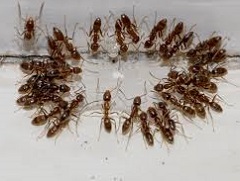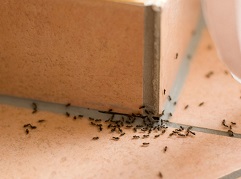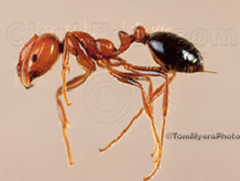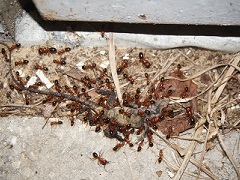ANT CONTROL IN SACRAMENTO AND SURROUNDING AREAS
-
Get Immediate Results
-
Same-Day Service
-
Complete Control of Ants
-
Over 25 Years of Pest Control Experience.
-
Licensed and Insured.
“YOU WILL GET THE BEST, MOST THOROUGH, PROFESSIONAL SERVICE YOU HAVE EVER SEEN…I GUARANTEE IT…OR IT’S FREE!” – PAUL BAUMEISTER, OPERATOR
Common House Ants
There are over 12,000 species of ants in the world, so it can be difficult to determine what kind of ants you’re seeing in your house. identification is an important step in controlling an invasion of ants. Master Pest Control has years of experience in stopping those invasive ant colonies from infesting your home.
Ants are social bugs and live in large colonies where each one has a specific role. If you are only seeing a few inside your home, there probably are thousands more nearby. And if you’re home supplies them with a steady food and water source, it’s likely you’ll have an invasion soon.
Since different types of ants require different treatment methods, you’ll first need to identify your specific ant. Here are 4 common ants you might see in and around your house. Also here are some tips to get rid of them:
Argentine Ants
 Sometimes called a sugar ant, the Argentine ant is one of the most commonly found ant specie inside homes throughout southern states. They’re very tiny (1/8 of an inch) and differ from shiny brown to black. They prefer sweet foods and will eat almost anything. Argentine ants can easily squeeze through small cracks and holes, and set up quarters in the ground, in concrete walls, in between boards and timbers, or among belongings in your home, and are often seen in higher numbers during dry or hot weather or after heavy rainfall.
Sometimes called a sugar ant, the Argentine ant is one of the most commonly found ant specie inside homes throughout southern states. They’re very tiny (1/8 of an inch) and differ from shiny brown to black. They prefer sweet foods and will eat almost anything. Argentine ants can easily squeeze through small cracks and holes, and set up quarters in the ground, in concrete walls, in between boards and timbers, or among belongings in your home, and are often seen in higher numbers during dry or hot weather or after heavy rainfall.
Because Argentine ants have a very strong trailing behavior, they exist in large groups, and move quickly, an infestation occurs quickly and can be hard to control. Using pesticides can often make the infestation worse since this can stimulate egg-laying by the queens in the colony. A professional will know how to identify and treat them properly.
Odorous House Ants
 As the name suggests, odorous house ants produce a strong smell when crushed, similar to rotten coconuts, and nest in and around homes. They’re dark-colored (1/8 of an inch or smaller). Odorous house ants exist in large numbers when there’s a nearby water source and are one of the hardest ants to get rid of once an infestation is established.
As the name suggests, odorous house ants produce a strong smell when crushed, similar to rotten coconuts, and nest in and around homes. They’re dark-colored (1/8 of an inch or smaller). Odorous house ants exist in large numbers when there’s a nearby water source and are one of the hardest ants to get rid of once an infestation is established.
Treatment of odorous house ants can vary but usually include a variety of applications. Your professional pest company will know how to properly eradicate this situation.
Fire Ants
 Fire ants are one of the easiest ants to identify because of their reddish-brown color and by the distinct dirt mounds they build. They’re also one of the most aggressive ant species and cause painful bites when they attack. Fire ants prefer to build mounds (nests) in open areas including yards, fields, and roadsides.
Fire ants are one of the easiest ants to identify because of their reddish-brown color and by the distinct dirt mounds they build. They’re also one of the most aggressive ant species and cause painful bites when they attack. Fire ants prefer to build mounds (nests) in open areas including yards, fields, and roadsides.
Fire ants are a common problem for homeowners for many reasons: they are a threat especially to pets and small children who are likely to be bitten if they come in contact with fire ants, they build unsightly, damaging mounds in your yard, and can cause severe reactions to those who are allergic. Granular baits work well to treat fire ants and can even eliminate entire colonies within 72 hours with a fire ant control service.
Carpenter Ants
 The various species of carpenter ants are the largest domestic species of ants. They’re larger than sugar ants and odorous house ants – usually 1/4 to 1 inch in size – and black. They’re also different from other ants as they cause structural damage. They like to nest inside the wood your home is constructed of, usually near a source of moisture. They’re nocturnal so you’re most likely to see them in the evenings or at night during summer months, when they leave their nest in search of food and water.
The various species of carpenter ants are the largest domestic species of ants. They’re larger than sugar ants and odorous house ants – usually 1/4 to 1 inch in size – and black. They’re also different from other ants as they cause structural damage. They like to nest inside the wood your home is constructed of, usually near a source of moisture. They’re nocturnal so you’re most likely to see them in the evenings or at night during summer months, when they leave their nest in search of food and water.
To prevent carpenter ants, eliminate sources of food and moisture, including repairs to any areas around your home where there’s evidence of water damage. Granular baits applied around the perimeter of the house and within the landscape work well to eliminate carpenter ants, in addition to gel baits applied along known trails, and perimeter treatments with non-repellent products.
